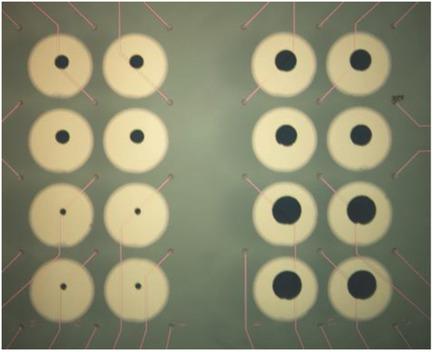当前位置:
X-MOL 学术
›
Adv. Mater.
›
论文详情
Our official English website, www.x-mol.net, welcomes your
feedback! (Note: you will need to create a separate account there.)
Direct Electrical Neurostimulation with Organic Pigment Photocapacitors
Advanced Materials ( IF 27.4 ) Pub Date : 2018-05-02 , DOI: 10.1002/adma.201707292 David Rand 1 , Marie Jakešová 2 , Gur Lubin 1 , Ieva Vėbraitė 3 , Moshe David‐Pur 1 , Vedran Đerek 2, 4 , Tobias Cramer 5 , Niyazi Serdar Sariciftci 6 , Yael Hanein 1 , Eric Daniel Głowacki 2
Advanced Materials ( IF 27.4 ) Pub Date : 2018-05-02 , DOI: 10.1002/adma.201707292 David Rand 1 , Marie Jakešová 2 , Gur Lubin 1 , Ieva Vėbraitė 3 , Moshe David‐Pur 1 , Vedran Đerek 2, 4 , Tobias Cramer 5 , Niyazi Serdar Sariciftci 6 , Yael Hanein 1 , Eric Daniel Głowacki 2
Affiliation

|
An efficient nanoscale semiconducting optoelectronic system is reported, which is optimized for neuronal stimulation: the organic electrolytic photocapacitor. The devices comprise a thin (80 nm) trilayer of metal and p–n semiconducting organic nanocrystals. When illuminated in physiological solution, these metal–semiconductor devices charge up, transducing light pulses into localized displacement currents that are strong enough to electrically stimulate neurons with safe light intensities. The devices are freestanding, requiring no wiring or external bias, and are stable in physiological conditions. The semiconductor layers are made using ubiquitous and nontoxic commercial pigments via simple and scalable deposition techniques. It is described how, in physiological media, photovoltage and charging behavior depend on device geometry. To test cell viability and capability of neural stimulation, photostimulation of primary neurons cultured for three weeks on photocapacitor films is shown. Finally, the efficacy of the device is demonstrated by achieving direct optoelectronic stimulation of light‐insensitive retinas, proving the potential of this device platform for retinal implant technologies and for stimulation of electrogenic tissues in general. These results substantiate the conclusion that these devices are the first non‐Si optoelectronic platform capable of sufficiently large photovoltages and displacement currents to enable true capacitive stimulation of excitable cells.
中文翻译:

用有机颜料光电电容器进行直接电神经刺激
报道了一种有效的纳米级半导体光电系统,该系统针对神经元刺激进行了优化:有机电解光电容器。该器件包括一个金属薄层(80 nm)和p–n半导体有机纳米晶体。当在生理溶液中照射时,这些金属半导体器件会充电,将光脉冲转换为局部位移电流,该位移电流足以以安全的光强度电刺激神经元。该设备是独立式的,不需要布线或外部偏压,并且在生理条件下稳定。半导体层是使用无处不在且无毒的市售颜料通过简单且可扩展的沉积技术制成的。描述了在生理介质中,光电压和充电行为如何取决于设备的几何形状。为了测试细胞活力和神经刺激能力,显示了在光电容器膜上培养三周的原代神经元的光刺激。最后,通过对光不敏感的视网膜进行直接光电刺激,证明了该设备的功效,证明了该设备平台在视网膜植入技术和总体上对电性组织刺激方面的潜力。这些结果证实了以下结论:这些器件是第一个具有足够大的光电压和位移电流的非硅光电平台,能够对可激发细胞进行真正的电容性刺激。通过对光不敏感的视网膜进行直接光电刺激,证明了该设备的功效,证明了该设备平台在视网膜植入技术和总体上对电性组织刺激方面的潜力。这些结果证实了以下结论:这些器件是第一个具有足够大的光电压和位移电流的非硅光电平台,能够对可激发细胞进行真正的电容性刺激。通过对光不敏感的视网膜进行直接光电刺激,证明了该设备的功效,证明了该设备平台在视网膜植入技术和总体上对电性组织刺激方面的潜力。这些结果证实了以下结论:这些器件是第一个具有足够大的光电压和位移电流的非硅光电平台,能够对可激发细胞进行真正的电容性刺激。
更新日期:2018-05-02
中文翻译:

用有机颜料光电电容器进行直接电神经刺激
报道了一种有效的纳米级半导体光电系统,该系统针对神经元刺激进行了优化:有机电解光电容器。该器件包括一个金属薄层(80 nm)和p–n半导体有机纳米晶体。当在生理溶液中照射时,这些金属半导体器件会充电,将光脉冲转换为局部位移电流,该位移电流足以以安全的光强度电刺激神经元。该设备是独立式的,不需要布线或外部偏压,并且在生理条件下稳定。半导体层是使用无处不在且无毒的市售颜料通过简单且可扩展的沉积技术制成的。描述了在生理介质中,光电压和充电行为如何取决于设备的几何形状。为了测试细胞活力和神经刺激能力,显示了在光电容器膜上培养三周的原代神经元的光刺激。最后,通过对光不敏感的视网膜进行直接光电刺激,证明了该设备的功效,证明了该设备平台在视网膜植入技术和总体上对电性组织刺激方面的潜力。这些结果证实了以下结论:这些器件是第一个具有足够大的光电压和位移电流的非硅光电平台,能够对可激发细胞进行真正的电容性刺激。通过对光不敏感的视网膜进行直接光电刺激,证明了该设备的功效,证明了该设备平台在视网膜植入技术和总体上对电性组织刺激方面的潜力。这些结果证实了以下结论:这些器件是第一个具有足够大的光电压和位移电流的非硅光电平台,能够对可激发细胞进行真正的电容性刺激。通过对光不敏感的视网膜进行直接光电刺激,证明了该设备的功效,证明了该设备平台在视网膜植入技术和总体上对电性组织刺激方面的潜力。这些结果证实了以下结论:这些器件是第一个具有足够大的光电压和位移电流的非硅光电平台,能够对可激发细胞进行真正的电容性刺激。











































 京公网安备 11010802027423号
京公网安备 11010802027423号